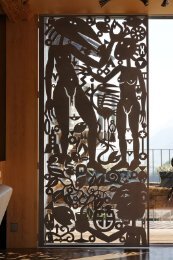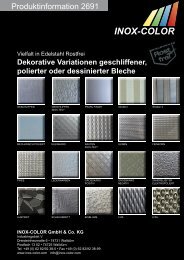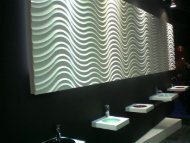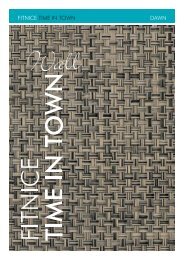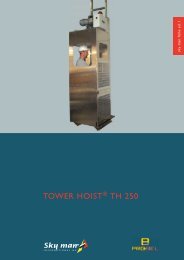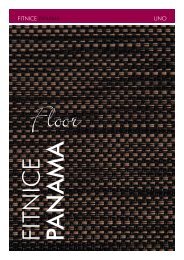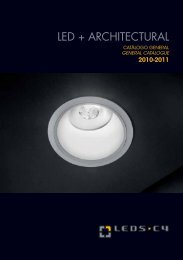Oltre il metallo -1- 20101112 p.1 - 42.cdr - DieMMe
Oltre il metallo -1- 20101112 p.1 - 42.cdr - DieMMe
Oltre il metallo -1- 20101112 p.1 - 42.cdr - DieMMe
You also want an ePaper? Increase the reach of your titles
YUMPU automatically turns print PDFs into web optimized ePapers that Google loves.
Isolamento termico<br />
Thermal insulation<br />
Isolamento termico<br />
Thermal insulation<br />
Il controsoffitto in genere non viene costruito per ottenere l’isolamento<br />
termico, ma certamente può contribuire ad ottenere questo risultato se<br />
nel realizzarlo vengono ut<strong>il</strong>izzati materiali adatti allo scopo.<br />
Quando si parla di “coibentazione” si esprime <strong>il</strong> concetto di isolamento<br />
termico. In sostanza si tende a creare una barriera tra l’interno di un<br />
ambiente e l’esterno, in modo tale da avere <strong>il</strong> più basso passaggio di<br />
calore. L’igrotermia, termine che riassume e raccoglie tutte le teorie su<br />
questo argomento, è una scienza importante che si basa su<br />
approfonditi studi ed esperienze che vengono continuamente<br />
aggiornati dall’impiego dei nuovi materiali che la tecnologia mette a<br />
disposizione in questo campo.<br />
È importante quindi, controllare le caratteristiche termiche di un<br />
materiale , osservando in prima istanza, la sua conduttività termica (l).<br />
La conduttività di un materiale indica <strong>il</strong> flusso di calore, per unità di<br />
area, che passa attraverso uno strato unitario del materiale (1 metro) in<br />
presenza di una differenza di temperatura di 1K. In pratica è <strong>il</strong> calore<br />
che migra da una parte all’altra di uno strato isolante E’evidente che più<br />
basso è questo valore, più isolante è <strong>il</strong> materiale preso in<br />
considerazione. Qui di seguito vi diamo alcuni esempi esplicativi e<br />
comparativi di materiali con le densità medie ut<strong>il</strong>izzate in ed<strong>il</strong>izia.<br />
Conduttività termica (I)<br />
• Poliuretani in lastre l = 0.032<br />
• Pannelli rigidi in fibra di vetro e lana minerale l = 0.230<br />
• Cartongesso l = 0.230<br />
• Intonaco in gesso I = 0.350<br />
• Pannelli in fibra di legno I = 0.150<br />
• Pannelli in sughero l = 0.045<br />
• Calcestruzzo naturale l = 1.200<br />
• Calcestruzzo cellulare l = 0.200<br />
• Piastrelle in gres e ceramica l = 1.000<br />
Una comparazione pratica sui diversi materiali è la seguente:<br />
l’isolamento termico risulta uguale con queste differenze di spessori:<br />
Lastre di poliuretani spessore 5 cm<br />
Fibra vetro e lane minerali spessore 9 cm<br />
Pannelli in sughero spessore 10 cm<br />
Pannelli in fibra di legno spessore 18 cm<br />
Calcestruzzo naturale spessore 150 cm<br />
A false ce<strong>il</strong>ing is not generally installed to meet this specific<br />
requirement, though it can certainly help achieve the desired result if it<br />
is produced using materials suitable for the purpose. When we talk<br />
about insulation, the concept we are actually expressing is thermal<br />
insulation. In short, we tend to create a barrier between the inside of a<br />
room and the outside so as to minimize the passage of heat between<br />
them.<br />
Hygrothermics, a term that summarizes and brings together all the<br />
theories on these subjects, is an important science based on in-depth<br />
studies and experience that are constantly updated by the use of new<br />
materials introduced by technology in this field.<br />
When checking the thermal properties of a material, all we need to do<br />
to start with is observing its thermal conductivity (l).<br />
The conductivity of a material indicates the flow of heat, per unit area,<br />
that passes through a single layer of the material (1 metre) when there<br />
is a temperature difference of 1K. In practice, this is the heat migrating<br />
from one part of my insulating layer to the other. Obviously, the lower<br />
this value, the greater the insulating power of the material in question.<br />
Below are a few explanatory and comparative examples of materials<br />
with average densities used in the bu<strong>il</strong>ding industry:<br />
Thermal conductivity (l)<br />
• Polyurethane sheets l = 0.032<br />
• Rigid fibreglass and mineral wool panels l = 0.230<br />
• Plasterboard l = 0.230<br />
• Gypsum plaster I = 0.350<br />
• Wood fibre panels l = 0.150<br />
• Cork panels l = 0.045<br />
• Natural concrete l = 1.200<br />
• Aerated concrete l = 0.200<br />
• Grès and ceramic t<strong>il</strong>es l = 1.000<br />
Here is a practical comparison of the various materials: resulting<br />
thermal insulation is the same with these different thicknesses:<br />
Polyurethane sheets thickness 5 cm<br />
Fiberglass and mineral wools thickness 9 cm<br />
Cork panels thickness 10 cm<br />
Wood fibre panels thickness 18 cm<br />
Natural concrete thickness 150 cm<br />
7.01




